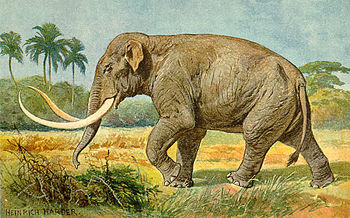- Imperial mammoth
-
Imperial Mammoth
Temporal range: Pliocene-Pleistocene
Mounted skeleton Scientific classification Kingdom: Animalia Phylum: Chordata Class: Mammalia Order: Proboscidea Family: Elephantidae Genus: Mammuthus Species: M. imperator Binomial name Mammuthus imperator
(Leidy, 1858) Imperial Mammoth, right foreleg. Historic photo from the Smithsonian Institution.
Imperial Mammoth, right foreleg. Historic photo from the Smithsonian Institution.
The Imperial Mammoth (Mammuthus imperator) is an extinct species of mammoth endemic to North America from the Pliocene through Pleistocene, living from 4.9 mya—11,000 years ago.[1]
It was said to be the second-largest known species of mammoth after the Songhua River Mammoth (Mammuthus sungari), and the largest on the Western Hemisphere reaching a height of 4.9 m (16 ft)[citation needed] at the shoulder. M. imperator ranged from Canada to New Mexico about 4.6 million - 17,000 years ago (Late Pleistocene). It was slightly larger than its more famous cousins, the Woolly Mammoth, the Steppe mammoth and several others. Because it was much warmer in central and southwestern North America than in northern Eurasia and North America, the Imperial Mammoth is not presumed to have had a thick fur coat like some of its relatives. It lived alongside Jefferson's Mammoth (Mammuthus jeffersonii) and the Columbian Mammoth (Mammuthus columbi). The latter is often confused with M. imperator, because of its similar size and fossil range. The primary way to distinguish the two mammoths is that M. imperator's tusks curve to the point of overlap, whereas M. columbi's tusks do not. M. imperator was originally described as a fossil species of Elephas by Joseph Leidy in 1858.[2]
Excellent fossils of the Imperial Mammoth have been found in the La Brea Tar Pits, in southern California.[3]
References
- ^ PaleoBiology Database: Mammuthus imperator, basic info
- ^ Leidy, J. (1858). "Notices of remains of extinct vertebrata, from the Valley of the Niobrara River, collected during the Exploring Expedition of 1857, in Nebraska under the command of Lieut. G.K. Warren, U.S. Top. Eng. By F.V. Hayden, Geologist to the Expedition.". Proceedings of the Academy of Natural Sciences,Philadelphia 10: 20–29.
- ^ Guenther, E. W. (1987). "Mammute und ihre Kümmerformen von Eurasien und Mexiko". Quartärpaläontologie 37/38: 13–51.
 Restoration by Heinrich Harder
Restoration by Heinrich Harder Categories:
Categories:- Pleistocene extinctions
- Pleistocene mammals
- Prehistoric elephants
Wikimedia Foundation. 2010.
